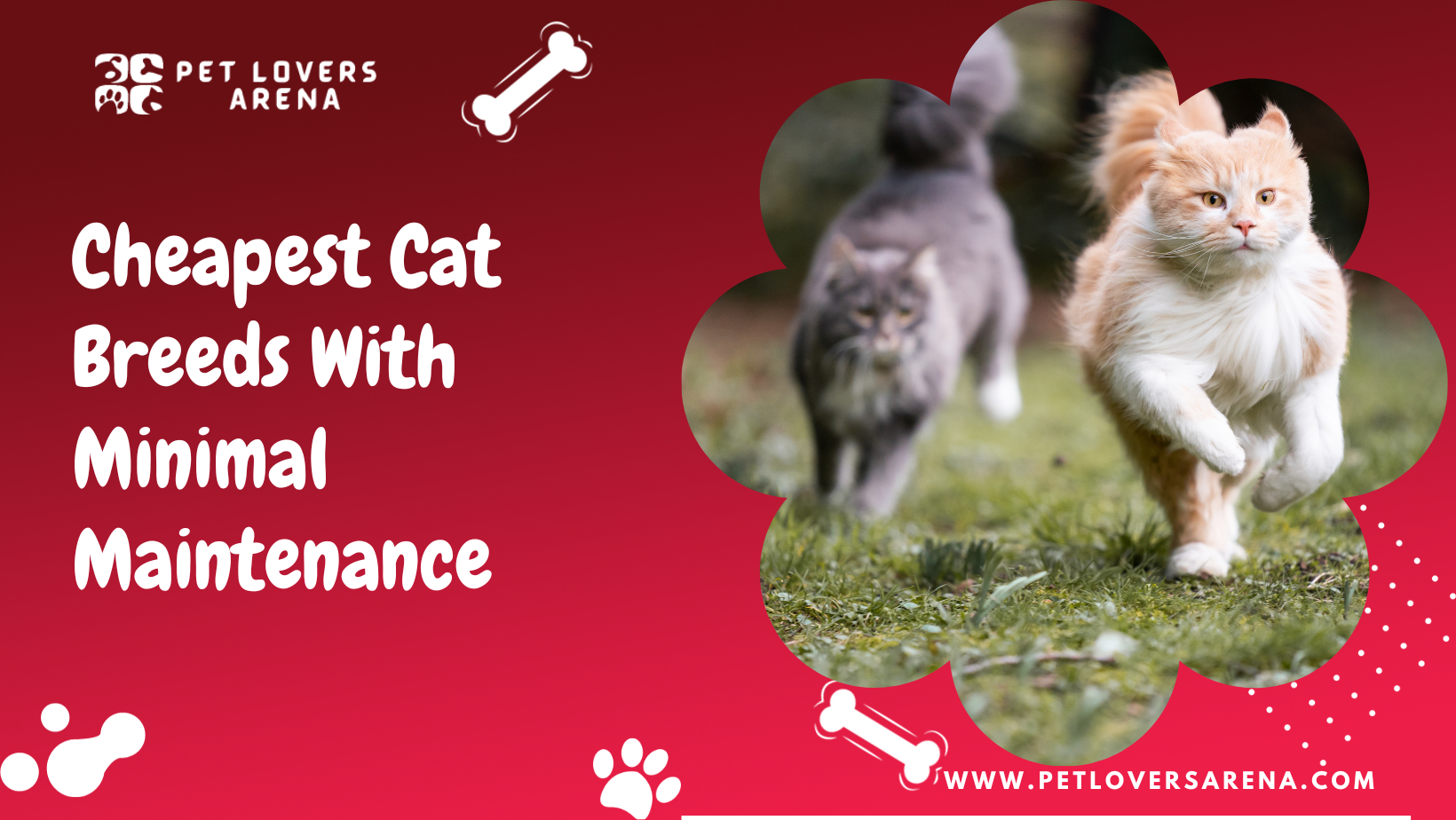Are you looking to adopt a cat but don’t want to break the bank or spend hours on grooming and upkeep? You’re in luck! Several cat breeds are not only low maintenance but also affordable. Whether you’re a first-time cat owner or simply looking for a furry friend who will require little time or money, these breeds are sure to fit the bill.
So what makes a cat low maintenance? Cats requiring minimal grooming, exercise, and medical care are generally considered low maintenance. This means they don’t shed excessively, don’t need frequent baths or haircuts, and are usually healthy and easy to care for.
Of course, every cat is different, and some breeds may require more or less maintenance than others. That’s why it’s important to research and choose a cat breed that fits your lifestyle and budget.
Key Takeaways:
- Several cat breeds are both low maintenance and affordable.
- Low-maintenance cats require minimal grooming, exercise, and medical care.
- When choosing a low-maintenance cat, it’s important to consider factors such as breed characteristics, lifestyle, and budget.
What Makes a Cat Low Maintenance?
When it comes to choosing a cat breed, one of the factors that many people consider is the level of maintenance required. Some cats are more high maintenance than others, requiring frequent grooming, exercise, and attention. However, many cat breeds are low maintenance and require minimal care.
Here are some characteristics that make a cat low maintenance:
- Short hair: Cats who have short hair require less grooming, whereas the ones with long hair. They shed less and are less prone to matting and tangles.
- Independent: Cats that are more independent and don’t require constant attention are generally easier to care for. They are content to spend time alone and don’t need to be entertained constantly.
- Low energy: Cats that are less active and don’t require a lot of exercise are generally easier to care for. They are happy to spend time lounging around the house and don’t need to be taken for walks or runs.
- Healthy: Cats that are healthy and don’t have any underlying health issues are generally easier to care for. They require fewer vet visits and are less likely to develop chronic conditions that require ongoing treatment.
Cheapest Cat Breeds with Low Maintenance
If you’re looking for a feline companion that is both affordable and requires minimal maintenance, you’re in luck. Many cat breeds fit this description, each with unique personalities and characteristics. Here are some of the cheapest cat breeds with low maintenance that you might want to consider:
1. Russian Blue
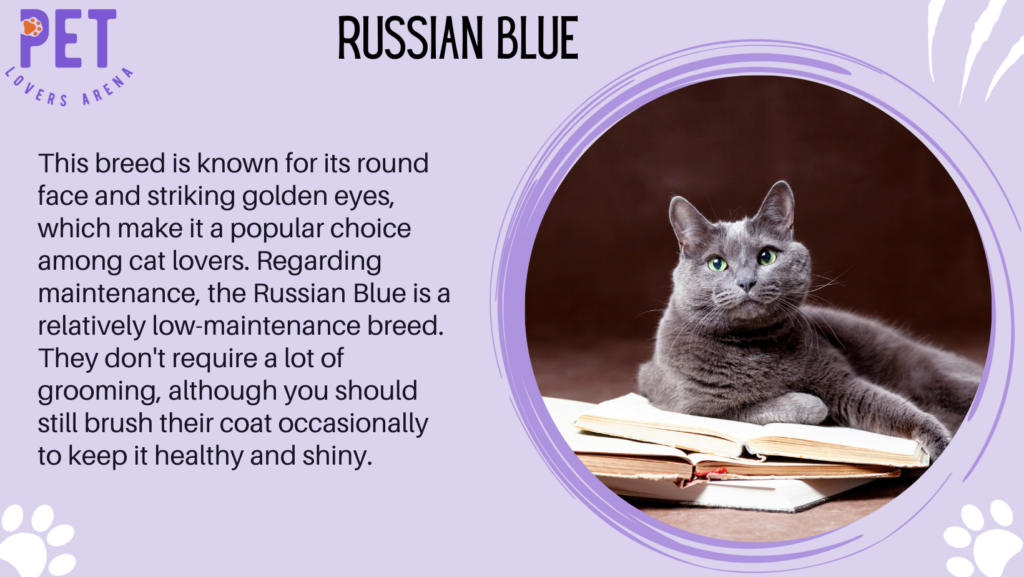
This breed is known for its round face and striking golden eyes, which make it a popular choice among cat lovers. Regarding maintenance, the Russian Blue is a relatively low-maintenance breed. They don’t require a lot of grooming, although you should still brush their coat occasionally to keep it healthy and shiny.
In terms of health, the Russian Blue is generally a healthy breed. To keep your Russian Blue healthy, feed them a balanced diet and take them to the vet for regular checkups. With their striking looks and easygoing nature, they’re sure to make a great addition to any household.
2. British Shorthair
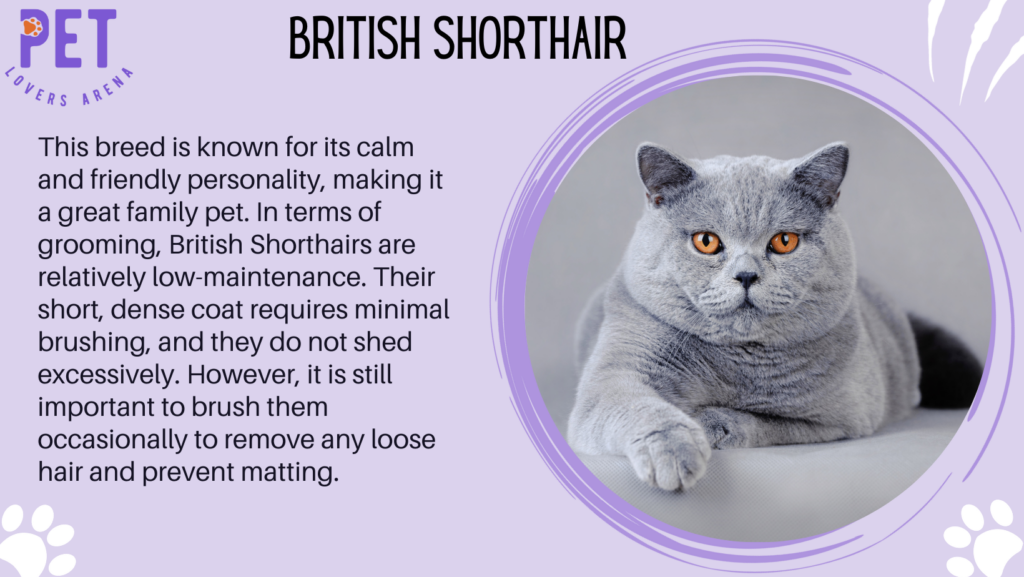
This breed is known for its calm and friendly personality, making it a great family pet. In terms of grooming, British Shorthairs are relatively low-maintenance. Their short, dense coat requires minimal brushing, and they do not shed excessively. However, it is still important to brush them occasionally to remove any loose hair and prevent matting.
When it comes to diet, British Shorthairs do not have any specific dietary requirements. However, feeding them a balanced and nutritious diet is important to maintain their overall health.
In terms of health, British Shorthairs are generally a healthy breed with few genetic health problems. Their calm and friendly personality makes them great companions for families and individuals.
3. Maine Coon
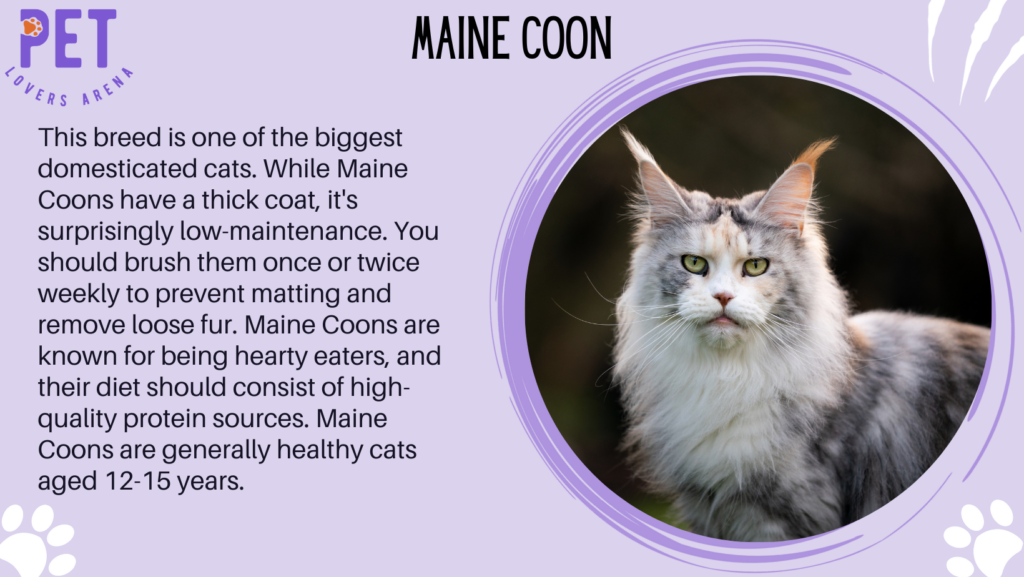
This breed is one of the biggest domesticated cats. While Maine Coons have a thick coat, it’s surprisingly low-maintenance. You should brush them once or twice weekly to prevent matting and remove loose fur.
Maine Coons are known for being hearty eaters, and their diet should consist of high-quality protein sources. Maine Coons are generally healthy cats aged 12-15 years. It’s important to take your cat for regular checkups and stay updated with their vaccinations.
4. American Shorthair
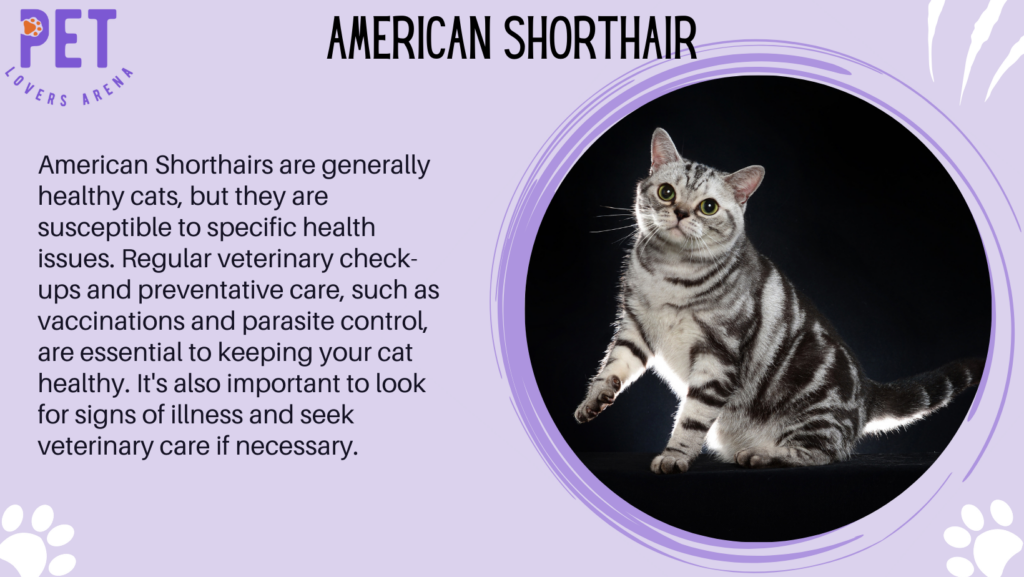
One of the great things about American Shorthairs is that they have a short, easy-to-care-for coat. Regular brushing and occasional bathing can keep their coat looking shiny and healthy. When it comes to feeding your American Shorthair, it’s important to provide them with a balanced diet that meets their nutritional needs.
American Shorthairs are generally healthy cats, but they are susceptible to specific health issues. Regular veterinary check-ups and preventative care, such as vaccinations and parasite control, are essential to keeping your cat healthy. It’s also important to look for signs of illness and seek veterinary care if necessary.
5. Devon Rex
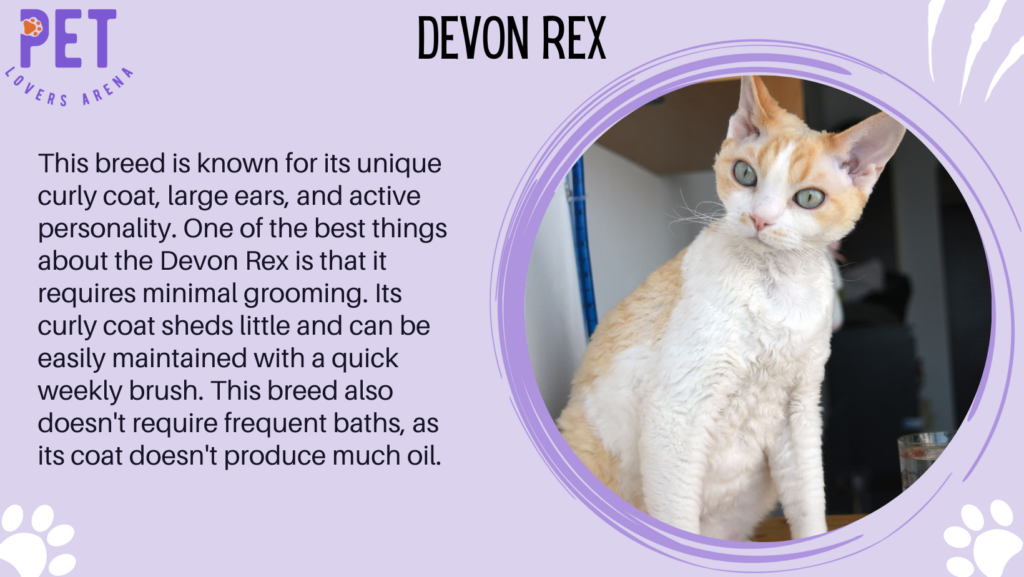
If you’re looking for a low-maintenance cat breed that is curious and playful, then the Devon Rex might be the perfect choice. This breed is known for its unique curly coat, large ears, and active personality.
One of the best things about the Devon Rex is that it requires minimal grooming. Its curly coat sheds little and can be easily maintained with a quick weekly brush. This breed also doesn’t require frequent baths, as its coat doesn’t produce much oil.
Regarding diet, the Devon Rex doesn’t have any specific requirements. Regarding health maintenance, the Devon Rex is generally a healthy breed. However, like all cats, they should receive regular veterinarian check-ups to stay healthy.
6. Birman
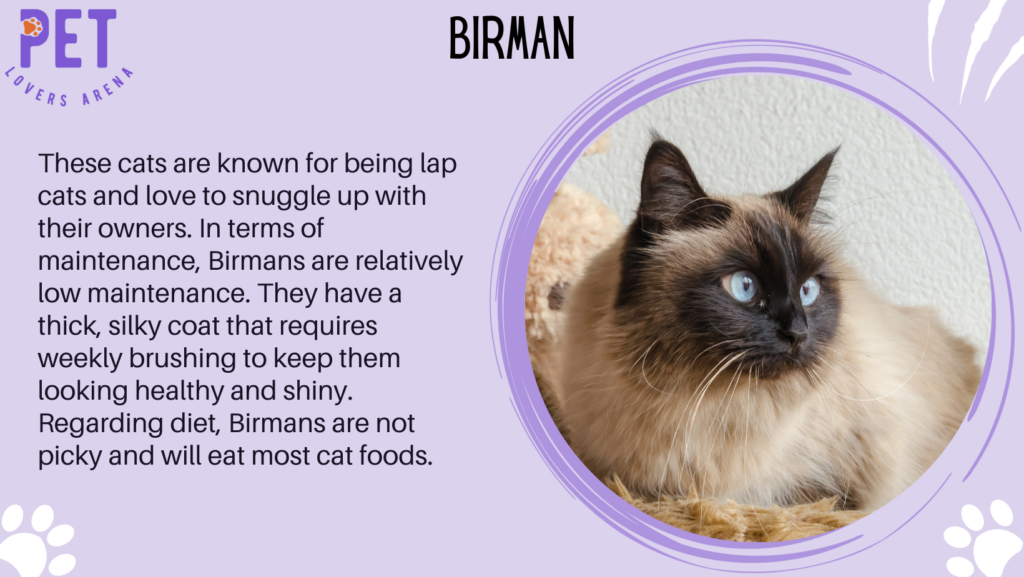
These cats are known for being lap cats and love to snuggle up with their owners. In terms of maintenance, Birmans are relatively low maintenance. They have a thick, silky coat that requires weekly brushing to keep them looking healthy and shiny.
Regarding diet, Birmans are not picky and will eat most cat foods. However, providing them with a balanced diet that meets their nutritional needs is important. You should also ensure they have access to fresh water at all times.
7. Scottish Fold

This breed is known for its unique round face and folded ears, which give it an adorable and distinctive appearance.
Scottish Folds are easy to take care of in terms of maintenance. They have a short, dense coat that doesn’t require a lot of grooming. Brushing them once a week should be sufficient to keep their coat in good condition. Regarding diet, Scottish Folds don’t have any specific requirements. Like all cats, they need a balanced protein, fat, and carbohydrate diet.
8. Oriental Shorthair
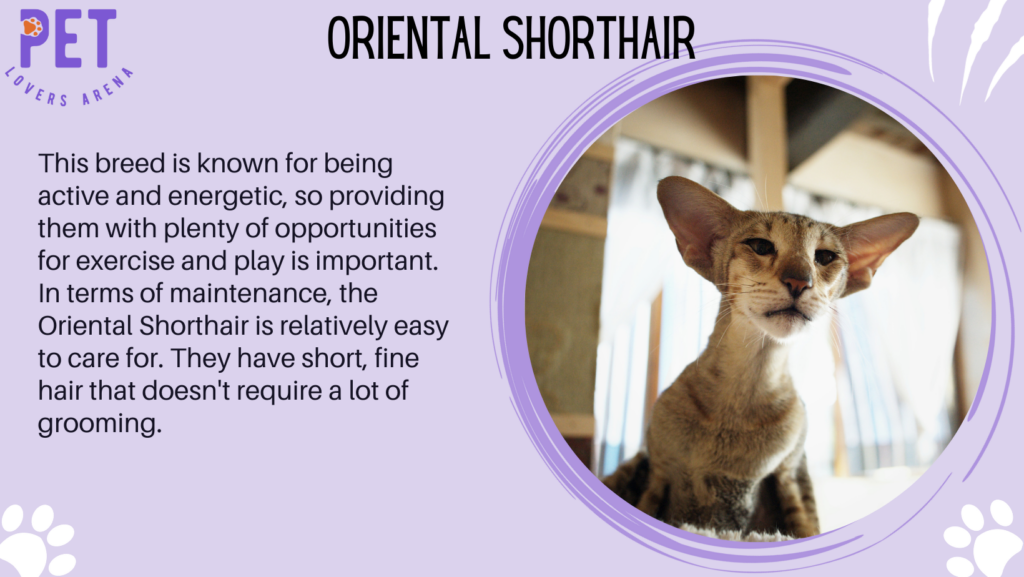
This breed is known for being active and energetic, so providing them with plenty of opportunities for exercise and play is important. In terms of maintenance, the Oriental Shorthair is relatively easy to care for. They have short, fine hair that doesn’t require a lot of grooming.
The Oriental Shorthair has no specific dietary requirements, but a balanced and nutritious diet is important to keep them healthy. Ensure to feed them high-quality cat food and avoid giving them too many treats.
9. Manx
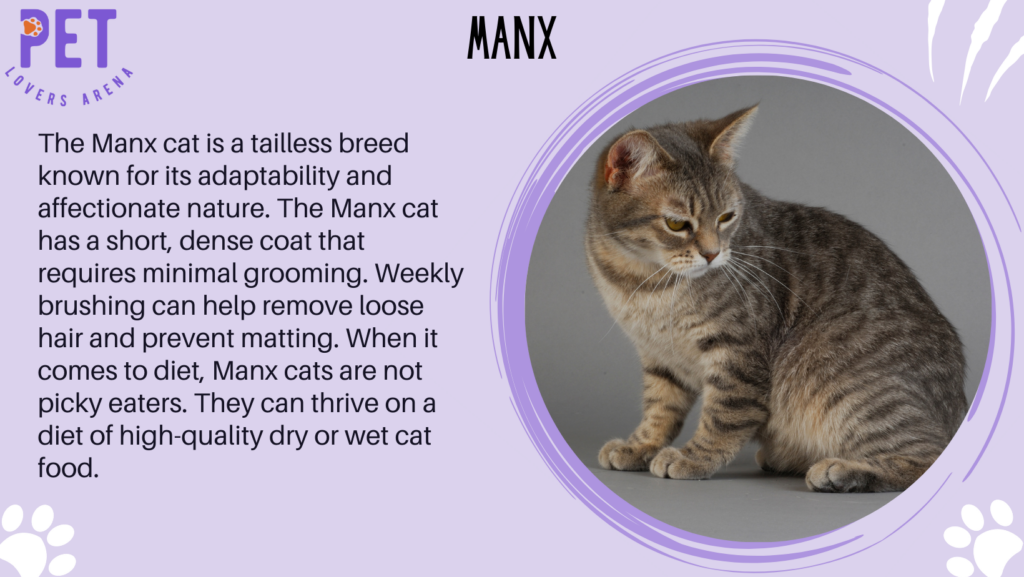
The Manx cat is a tailless breed known for its adaptability and affectionate nature. The Manx cat has a short, dense coat that requires minimal grooming. Weekly brushing can help remove loose hair and prevent matting. When it comes to diet, Manx cats are not picky eaters. They can thrive on a diet of high-quality dry or wet cat food.
Manx cats are generally healthy cats, but they are prone to specific health issues, such as spinal problems and digestive issues. Regular visits to the vet can help prevent or detect these issues early on.
10. Turkish Angora
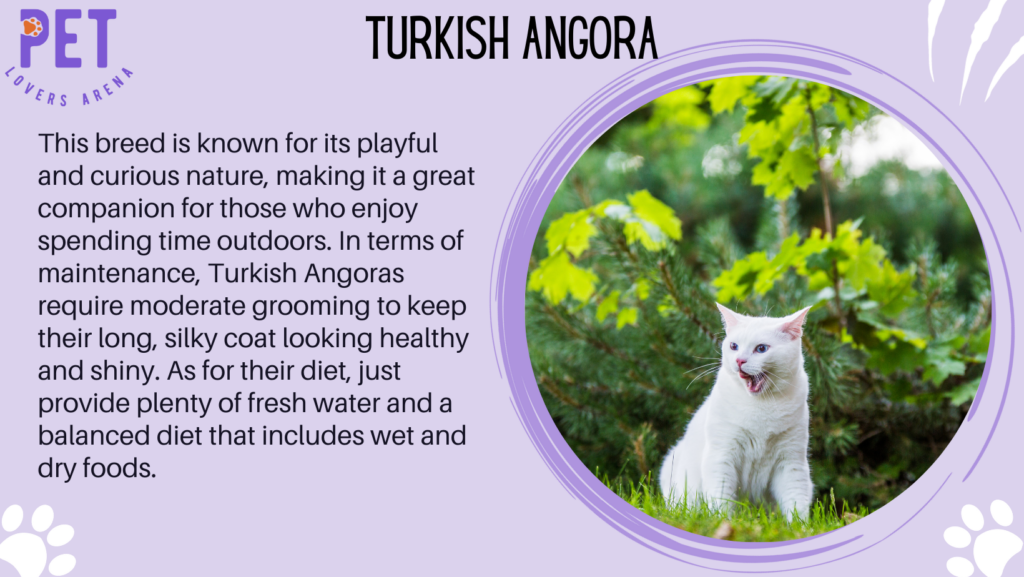
This breed is known for its playful and curious nature, making it a great companion for those who enjoy spending time outdoors. In terms of maintenance, Turkish Angoras require moderate grooming to keep their long, silky coat looking healthy and shiny.
You’ll need to brush them at least once a week to prevent matting and tangling, and they may need more frequent grooming during shedding season. As for their diet, just provide plenty of fresh water and a balanced diet that includes wet and dry foods.
11. Javanese
If you’re looking for a friendly cat breed that is low maintenance, the Javanese may be the perfect fit for you. These cats are affectionate and playful personalities, making them an excellent choice for families with children or other pets.
In terms of maintenance, the Javanese is relatively easy to care for. They have short, fine coats that require minimal grooming, so you won’t have to spend much time brushing or bathing them. When it comes to diet, make sure to provide fresh water at all times to keep them hydrated and healthy.
12. European Shorthair Cat
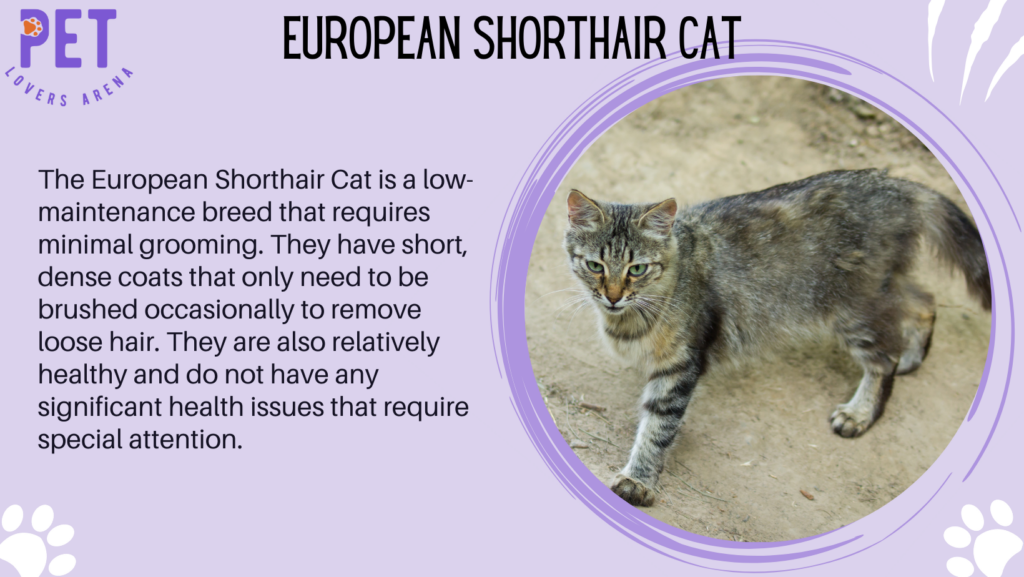
The European Shorthair Cat is a low-maintenance breed that requires minimal grooming. They have short, dense coats that only need to be brushed occasionally to remove loose hair. They are also relatively healthy and do not have any significant health issues that require special attention.
To keep your European Shorthair Cat healthy, provide them with a balanced diet and plenty of fresh water. Regular veterinary check-ups are mandatory to catch potential health issues early on. Regarding exercise, European Shorthair Cats are relatively active and playful, so providing them with toys and playtime is essential to keep them happy and healthy.
13. Ragdoll
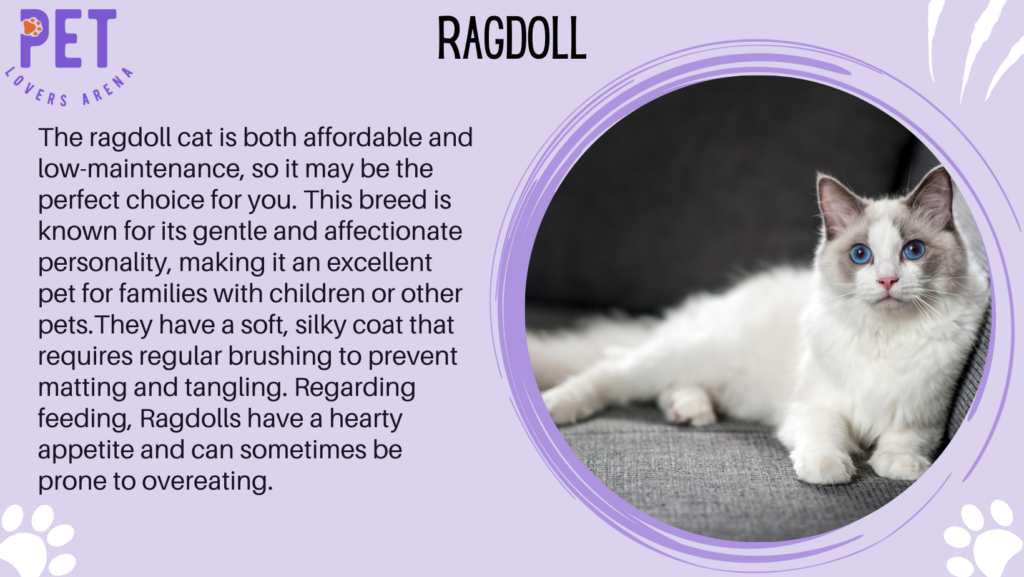
The ragdoll cat is both affordable and low-maintenance, so it may be the perfect choice for you. This breed is known for its gentle and affectionate personality, making it an excellent pet for families with children or other pets.
In terms of maintenance, Ragdolls are relatively easy to care for. They have a soft, silky coat that requires regular brushing to prevent matting and tangling. Regarding feeding, Ragdolls have a hearty appetite and can sometimes be prone to overeating.
14. Bombay Cat
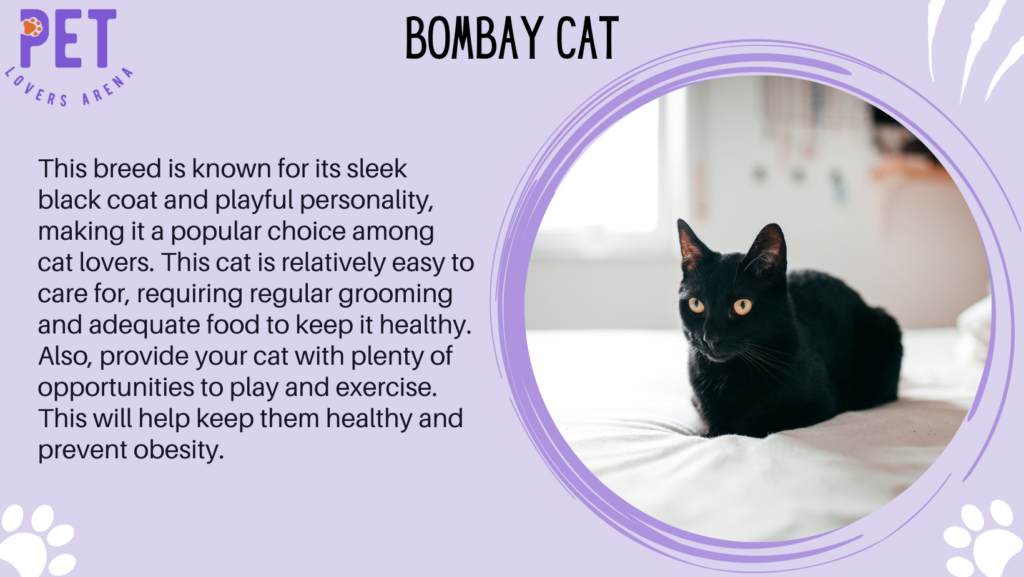
This breed is known for its sleek black coat and playful personality, making it a popular choice among cat lovers. This cat is relatively easy to care for, requiring regular grooming and adequate food to keep it healthy. Also, provide your cat with plenty of opportunities to play and exercise. This will help keep them healthy and prevent obesity.
In terms of maintenance, the Bombay cat is an excellent choice for anyone looking for an affordable and easy-to-care-for pet. With proper care and attention, your Bombay cat will be a loving companion for many years.
15. Burmese
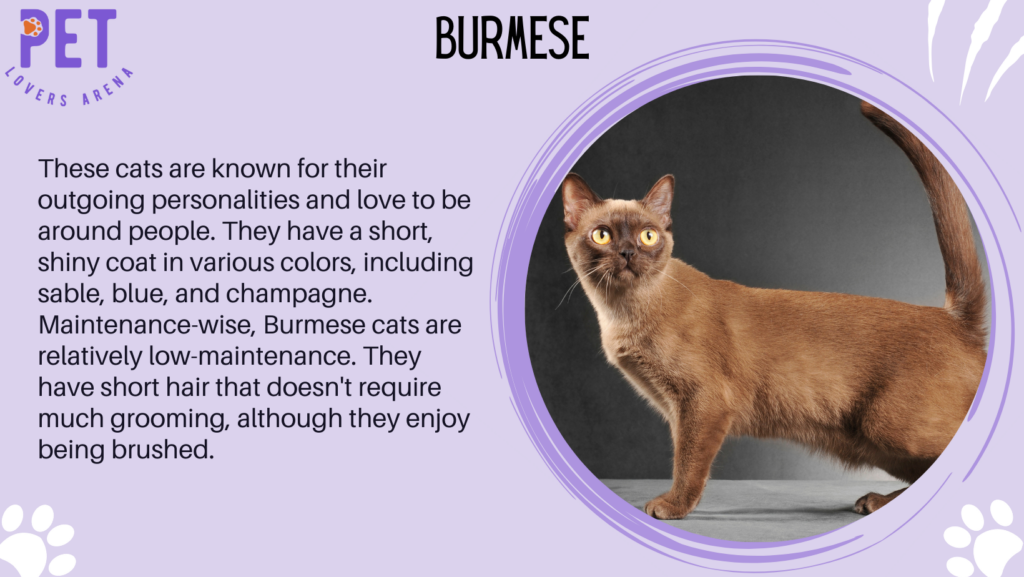
These cats are known for their outgoing personalities and love to be around people. They have a short, shiny coat in various colors, including sable, blue, and champagne. Maintenance-wise, Burmese cats are relatively low-maintenance. They have short hair that doesn’t require much grooming, although they enjoy being brushed.
They are also known to be relatively healthy and don’t require any special diets or medications. Regarding exercise, Burmese cats are quite active and enjoy playing. They are also exceptionally social and enjoy interacting with their owners. The Burmese might be the perfect choice if you’re looking for a cat to keep you company and be your constant companion.
16. Sphynx Cat
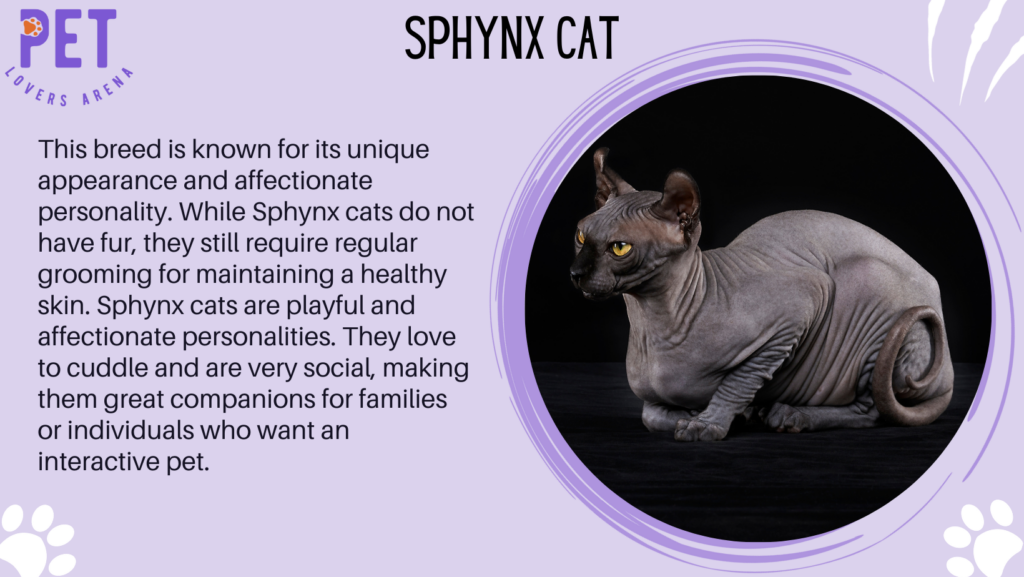
If you’re looking for a hairless feline friend, the Sphynx cat might be the right choice. This breed is known for its unique appearance and affectionate personality. While Sphynx cats do not have fur, they still require regular grooming for maintaining a healthy skin.
Sphynx cats are playful and affectionate personalities. They love to cuddle and are very social, making them great companions for families or individuals who want an interactive pet. You can expect to pay anywhere from $1,500 to $3,000 for a Sphynx kitten.
17. Abyssinian
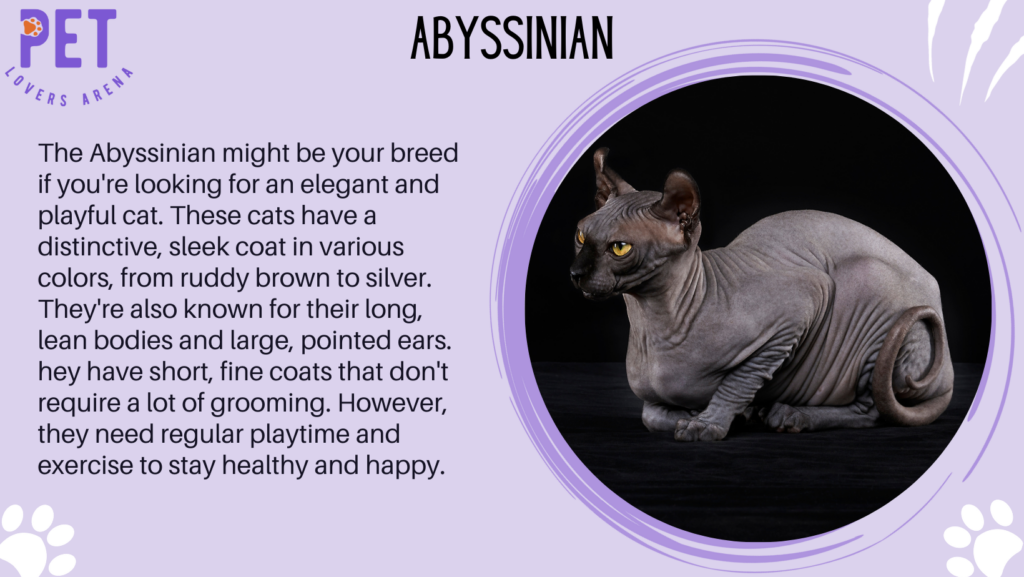
The Abyssinian might be your breed if you’re looking for an elegant and playful cat. These cats have a distinctive, sleek coat in various colors, from ruddy brown to silver. They’re also known for their long, lean bodies and large, pointed ears.
In terms of maintenance, Abyssinians are relatively low-maintenance cats. They have short, fine coats that don’t require a lot of grooming. However, they need regular playtime and exercise to stay healthy and happy. Be sure to provide your Abyssinian with plenty of toys and opportunities to play, and consider setting up a cat tree or other climbing structure to keep them active.
18. Cornish Rex
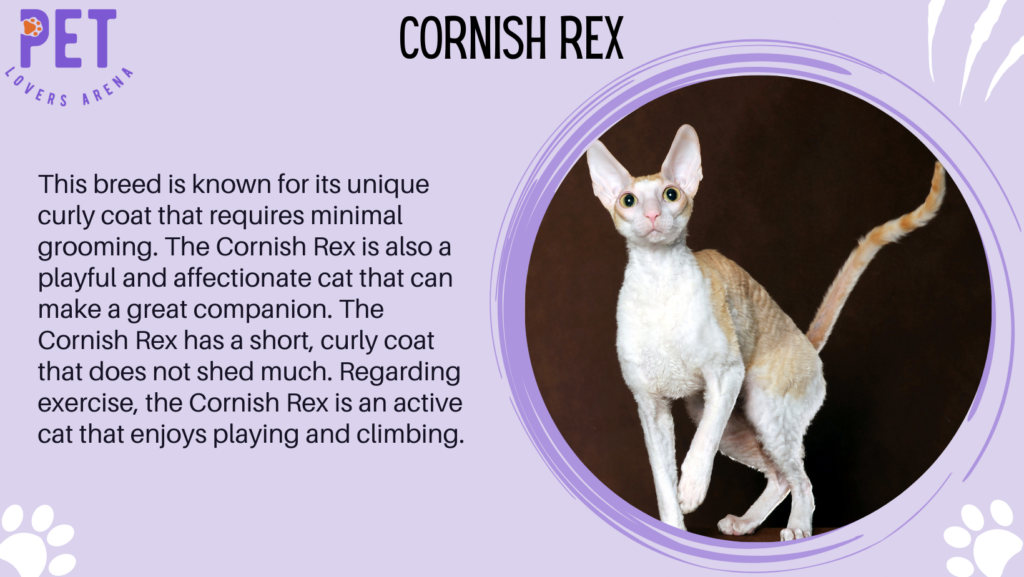
This breed is known for its unique curly coat that requires minimal grooming. The Cornish Rex is also a playful and affectionate cat that can make a great companion.
The Cornish Rex has a short, curly coat that does not shed much. Regarding exercise, the Cornish Rex is an active cat that enjoys playing and climbing. You should entertain your cat with plenty of toys and scratching posts. You should also ensure that your cat has access to fresh water and a healthy diet.
19. Tonkinese
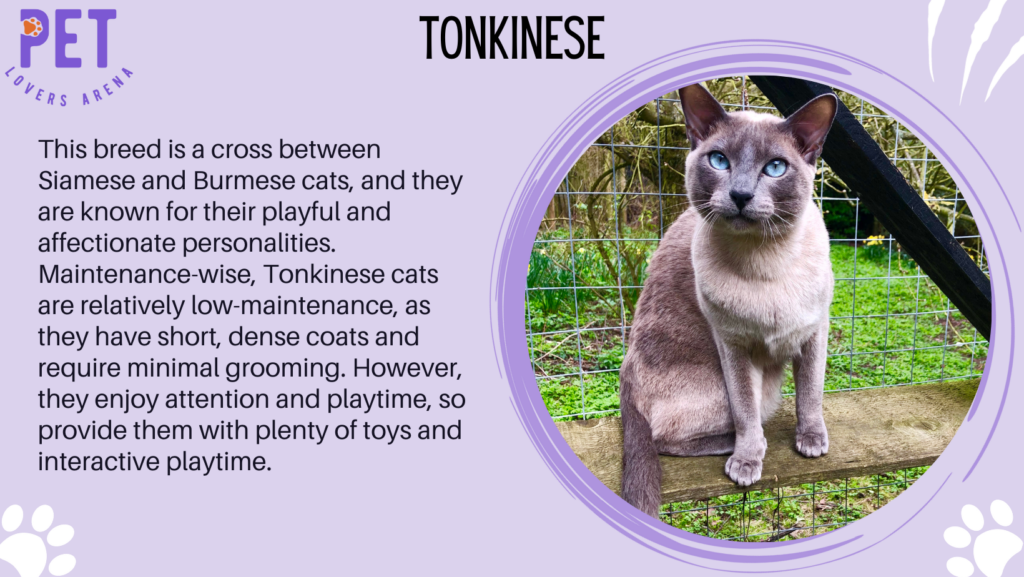
This breed is a cross between Siamese and Burmese cats, and they are known for their playful and affectionate personalities. Maintenance-wise, Tonkinese cats are relatively low-maintenance, as they have short, dense coats and require minimal grooming. However, they enjoy attention and playtime, so provide them with plenty of toys and interactive playtime.
Tonkinese cats are also known for being relatively healthy, with few breed-specific health issues. However, as with any cat, regular vet check-ups are essential to ensure your cat stays healthy.
20. Ocicat
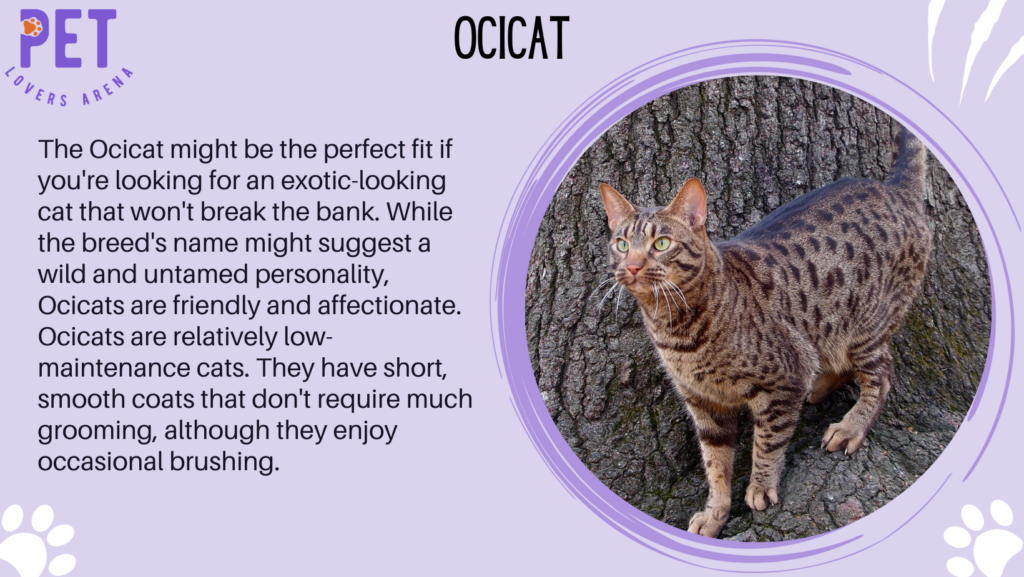
The Ocicat might be the perfect fit if you’re looking for an exotic-looking cat that won’t break the bank. While the breed’s name might suggest a wild and untamed personality, Ocicats are friendly and affectionate. Ocicats are relatively low-maintenance cats. They have short, smooth coats that don’t require much grooming, although they enjoy occasional brushing.
They are also generally healthy cats with no significant health concerns specific to the breed. However, like all cats, they require regular veterinary check-ups, vaccinations, and preventative care to stay healthy. It’s also important to provide them with plenty of mental and physical stimulation, such as toys, scratching posts, and playtime with their humans.
21. Pixiebob
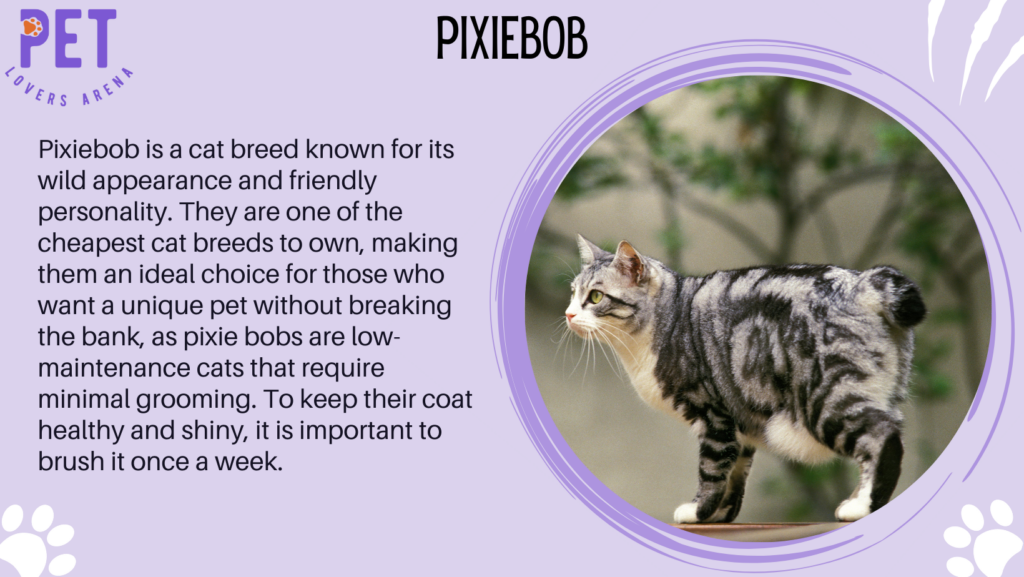
Pixiebob is a cat breed known for its wild appearance and friendly personality. They are one of the cheapest cat breeds to own, making them an ideal choice for those who want a unique pet without breaking the bank, as pixie bobs are low-maintenance cats that require minimal grooming. To keep their coat healthy and shiny, it is important to brush it once a week.
They are generally healthy cats, but it is important to keep up with regular vet check-ups to ensure they remain healthy. Pixiebobs are active cats and benefit from regular playtime and exercise. Providing them with toys and scratching posts will help keep them entertained and happy.
22. Siberian
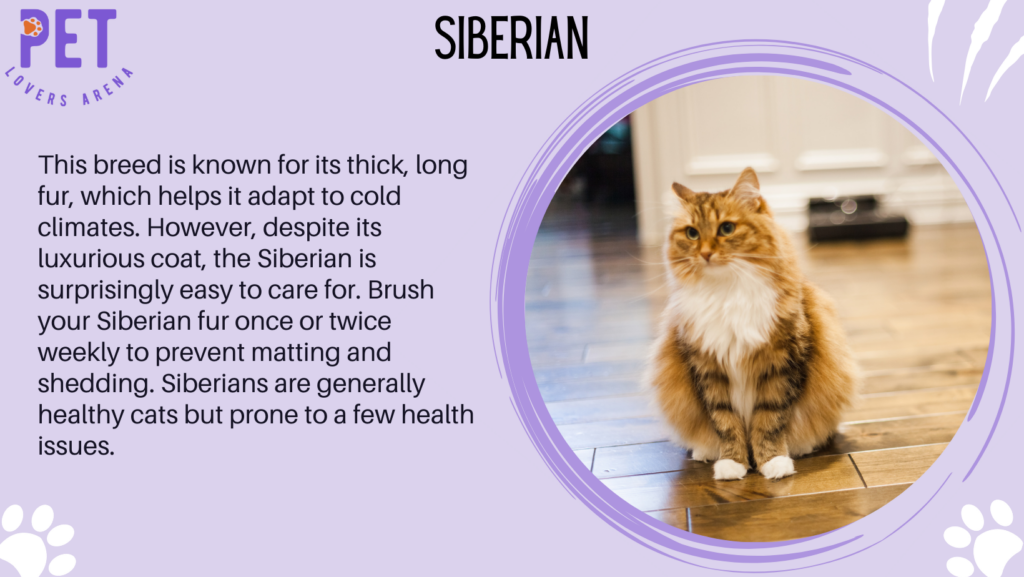
This breed is known for its thick, long fur, which helps it adapt to cold climates. However, despite its luxurious coat, the Siberian is surprisingly easy to care for. Brush your Siberian fur once or twice weekly to prevent matting and shedding.
Siberians are generally healthy cats but prone to a few health issues. To minimize the risk of these health issues, buy your Siberian from a reputable breeder who screens their cats for genetic disorders.
23. Singapura
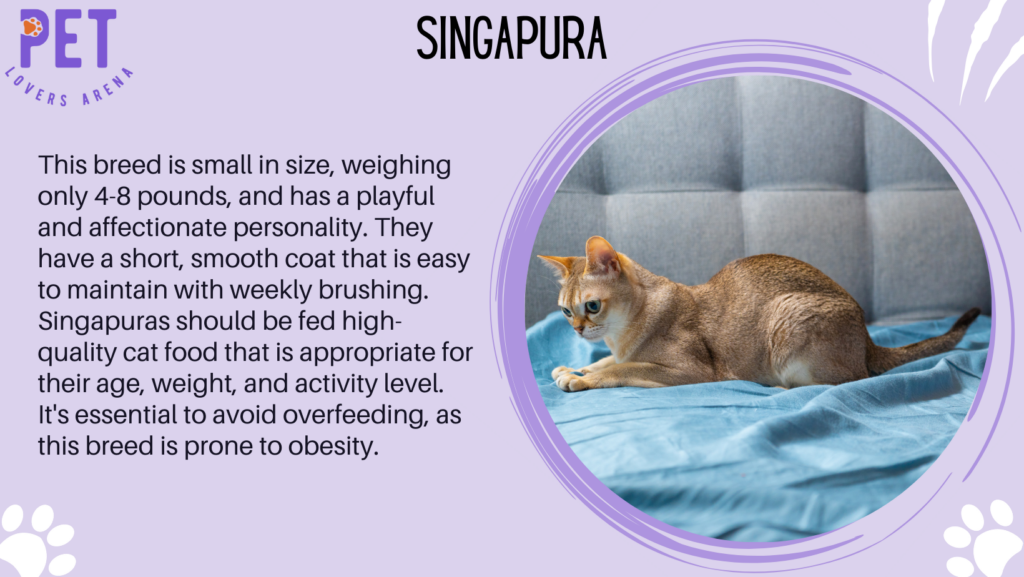
This breed is small in size, weighing only 4-8 pounds, and has a playful and affectionate personality. They have a short, smooth coat that is easy to maintain with weekly brushing.
In terms of maintenance, the Singapura is a relatively low-maintenance breed. They don’t require special grooming or care, but keeping up with regular vet check-ups and vaccinations is essential to ensure their health. Singapuras should be fed high-quality cat food that is appropriate for their age, weight, and activity level. It’s essential to avoid overfeeding, as this breed is prone to obesity.
24. Persian
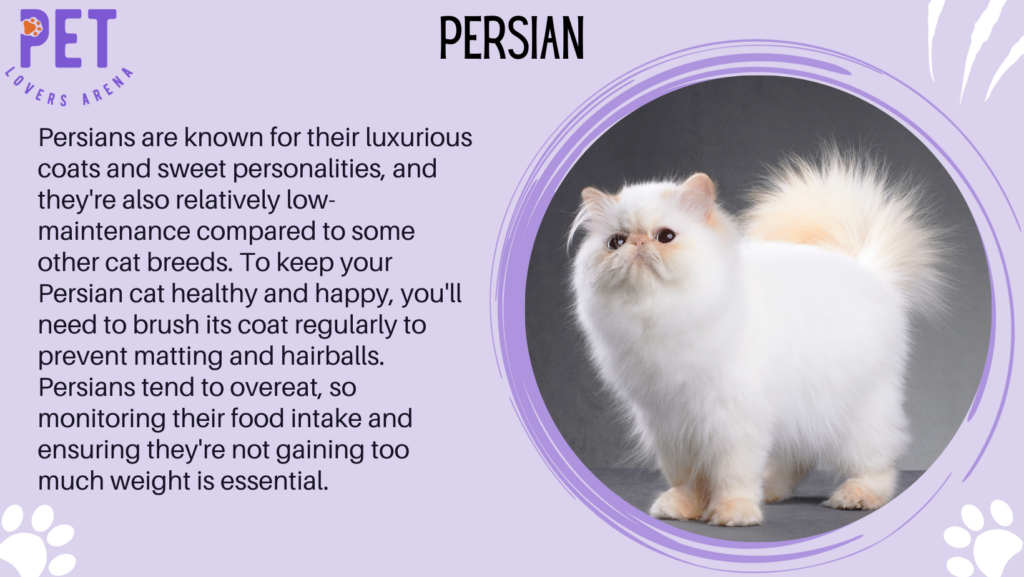
Persians are known for their luxurious coats and sweet personalities, and they’re also relatively low-maintenance compared to some other cat breeds.
To keep your Persian cat healthy and happy, you’ll need to brush its coat regularly to prevent matting and hairballs. Persians tend to overeat, so monitoring their food intake and ensuring they’re not gaining too much weight is essential.
25. Exotic Shorthair
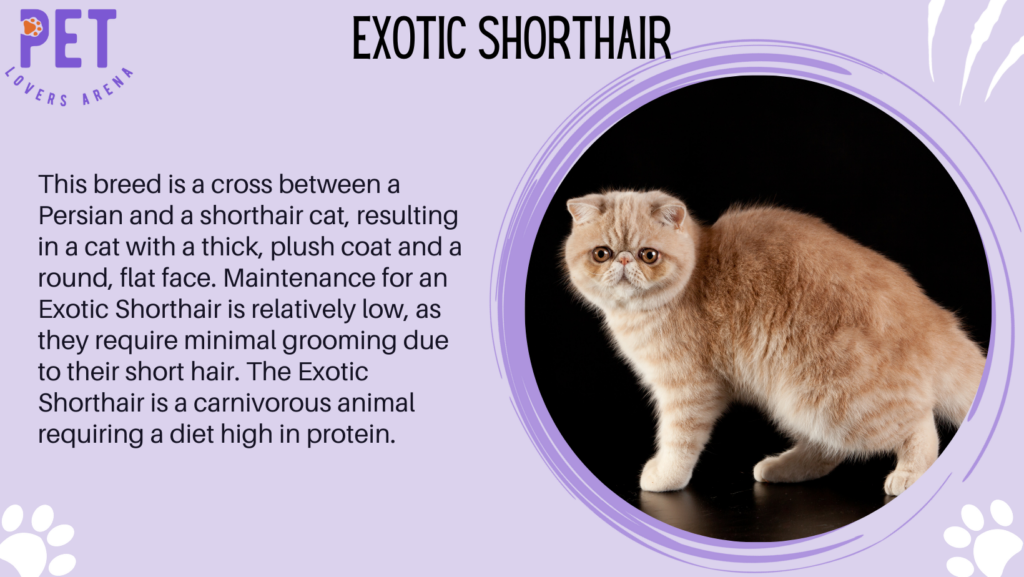
This breed is a cross between a Persian and a shorthair cat, resulting in a cat with a thick, plush coat and a round, flat face. Maintenance for an Exotic Shorthair is relatively low, as they require minimal grooming due to their short hair.
The Exotic Shorthair is a carnivorous animal requiring a diet high in protein. Feeding your cat a balanced diet that includes wet and dry food is important. You should also provide your cat with fresh water at all times.
26. Somali
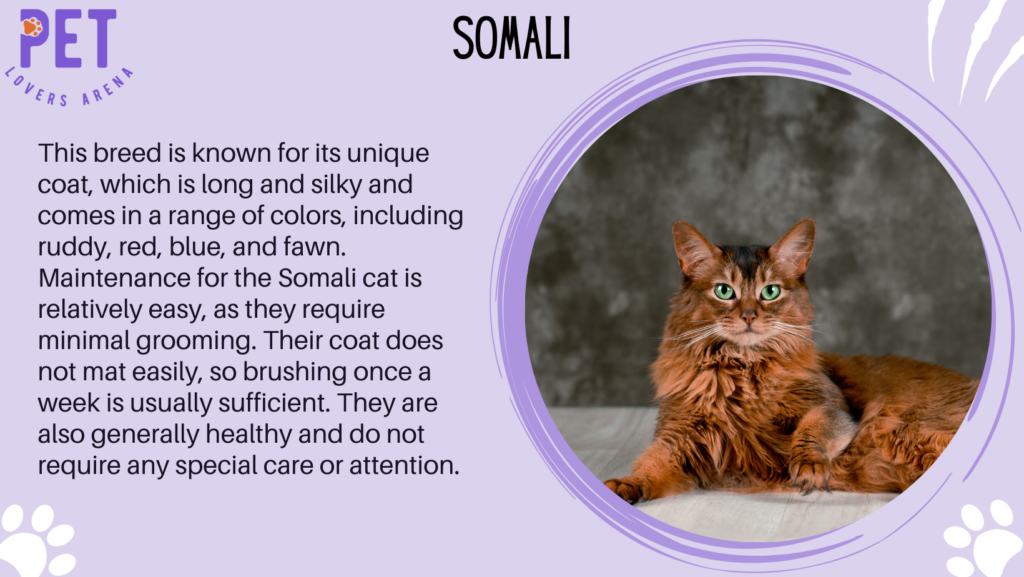
If you are looking for a cat breed that is both beautiful and affordable, the Somali cat may be an excellent option for you. This breed is known for its unique coat, which is long and silky and comes in a range of colors, including ruddy, red, blue, and fawn.
Maintenance for the Somali cat is relatively easy, as they require minimal grooming. Their coat does not mat easily, so brushing once a week is usually sufficient. They are also generally healthy and do not require any special care or attention.
27. Norwegian Forest
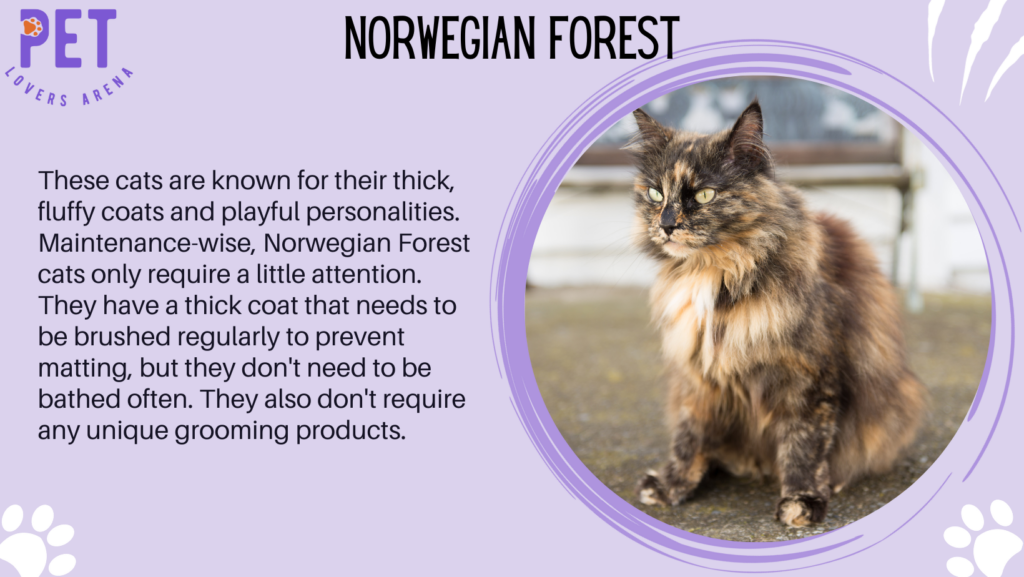
These cats are known for their thick, fluffy coats and playful personalities. Maintenance-wise, Norwegian Forest cats only require a little attention. They have a thick coat that needs to be brushed regularly to prevent matting, but they don’t need to be bathed often. They also don’t require any unique grooming products.
In terms of health, Norwegian Forest cats are generally healthy and don’t have any significant health issues. When it comes to feeding, Norwegian Forest cats have a healthy appetite and will eat just about anything you give them. They are friendly, playful, and easy to care for, making them a great addition to any household.
28. Himalayan
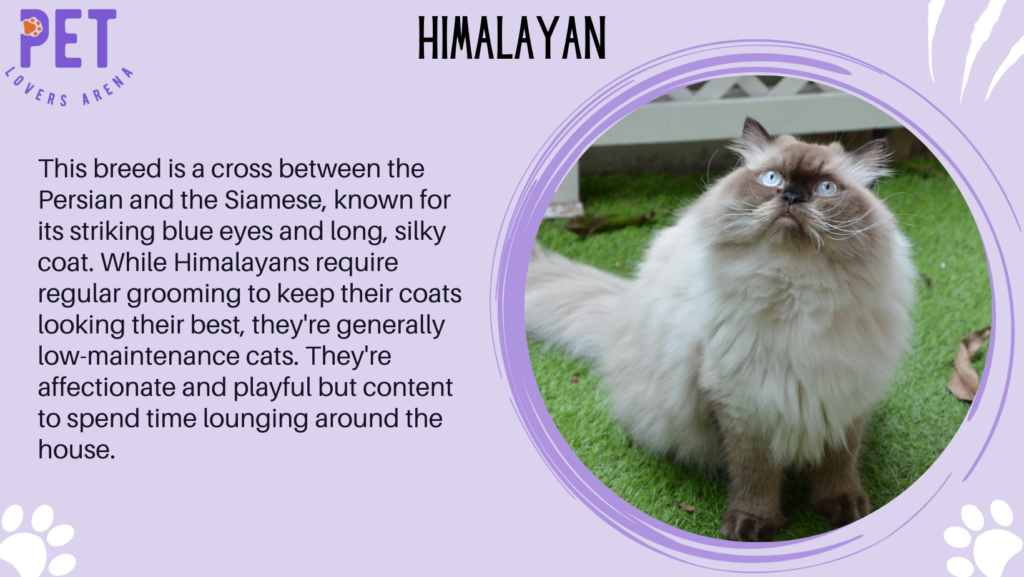
This breed is a cross between the Persian and the Siamese, known for its striking blue eyes and long, silky coat. While Himalayans require regular grooming to keep their coats looking their best, they’re generally low-maintenance cats. They’re affectionate and playful but content to spend time lounging around the house.
Himalayans must be brushed regularly to prevent matting and tangling of their long hair. Taking your cat to the vet for regular check-ups and keeping up with vaccinations and preventative care is essential.
29. American Wirehair
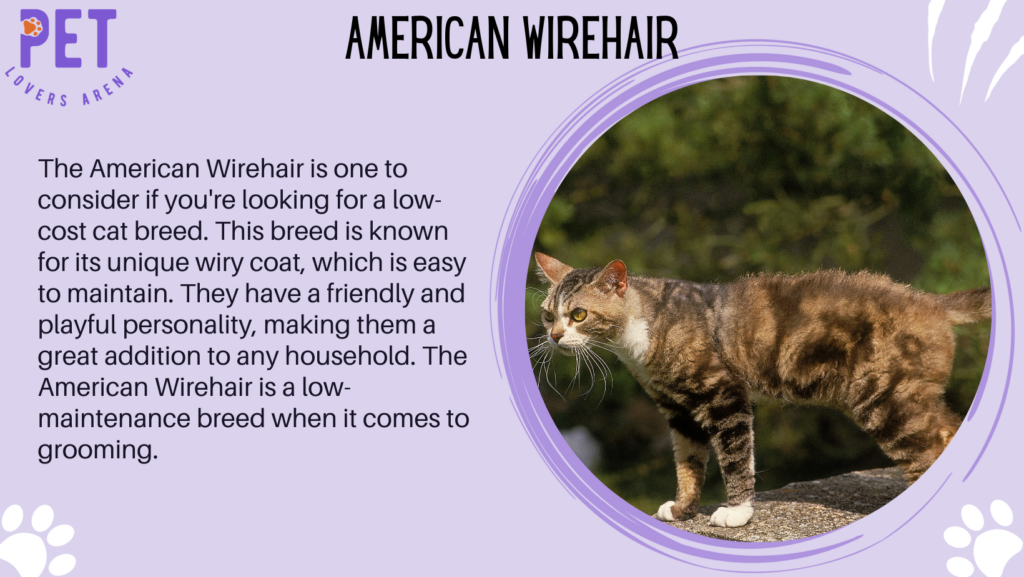
The American Wirehair is one to consider if you’re looking for a low-cost cat breed. This breed is known for its unique wiry coat, which is easy to maintain. They have a friendly and playful personality, making them a great addition to any household. The American Wirehair is a low-maintenance breed when it comes to grooming.
Their coat is naturally resistant to tangles and matting, so you won’t need to brush them often. A weekly brushing with a soft bristle brush is enough to keep their coat looking healthy and shiny. They are also a healthy breed, with no known health issues specific to the species. However, as with any cat, regular visits to the vet are recommended to ensure their overall health.
30. Snowshoe
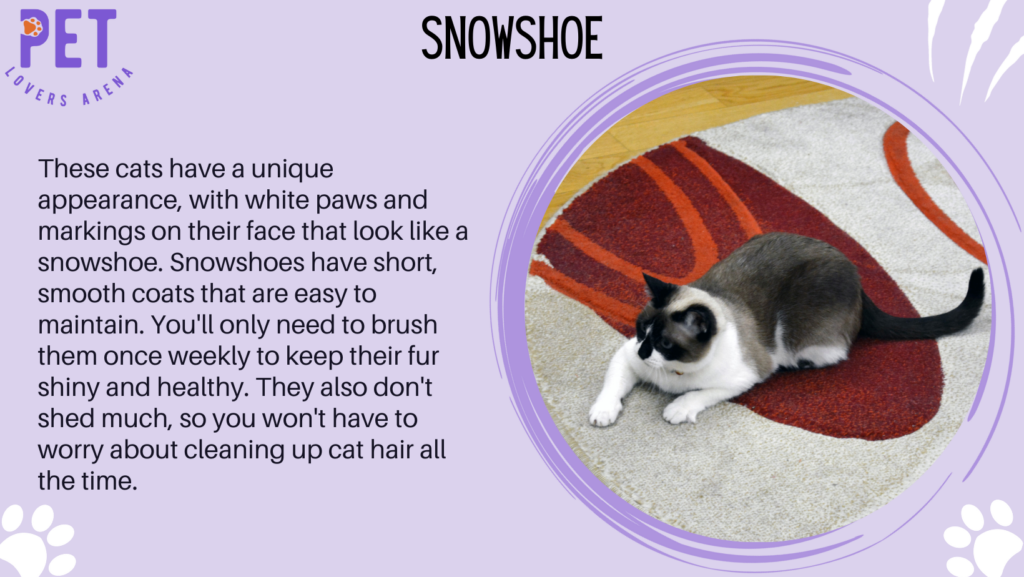
These cats have a unique appearance, with white paws and markings on their face that look like a snowshoe. Snowshoes have short, smooth coats that are easy to maintain. You’ll only need to brush them once weekly to keep their fur shiny and healthy. They also don’t shed much, so you won’t have to worry about cleaning up cat hair all the time.
In terms of grooming, you’ll need to trim their nails every few weeks to keep them from getting too long. Get plenty of exercise and a healthy diet to keep your Snowshoe healthy. You should also take them to the vet for regular checkups and vaccinations.
31. Havana Brown
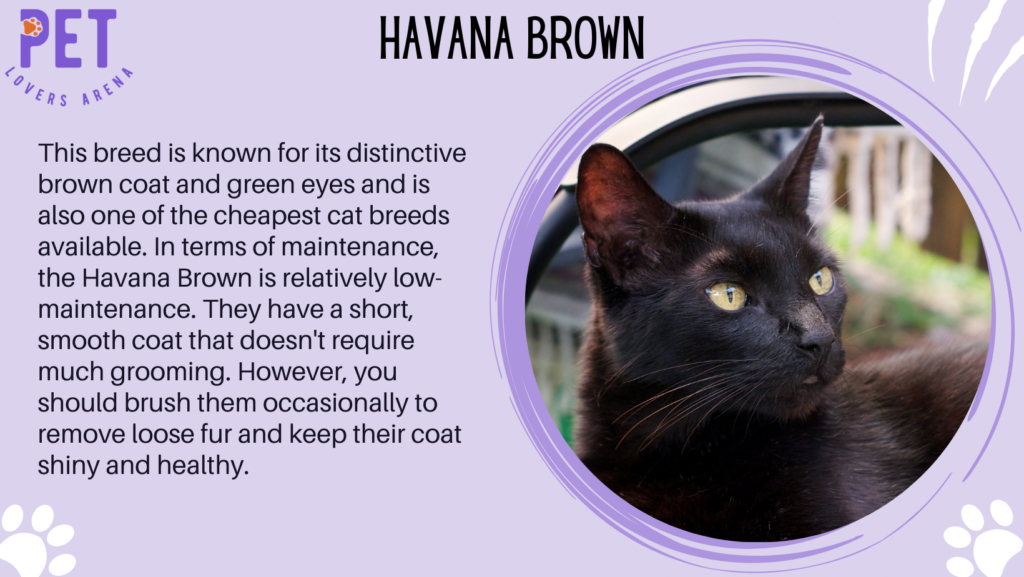
This breed is known for its distinctive brown coat and green eyes and is also one of the cheapest cat breeds available. In terms of maintenance, the Havana Brown is relatively low-maintenance. They have a short, smooth coat that doesn’t require much grooming. However, you should brush them occasionally to remove loose fur and keep their coat shiny and healthy.
When it comes to feeding your Havana Brown, you should provide them with a portion of high-quality cat food that meets their nutritional needs and make sure they have access to plenty of fresh water at all times.
32. Munchkin
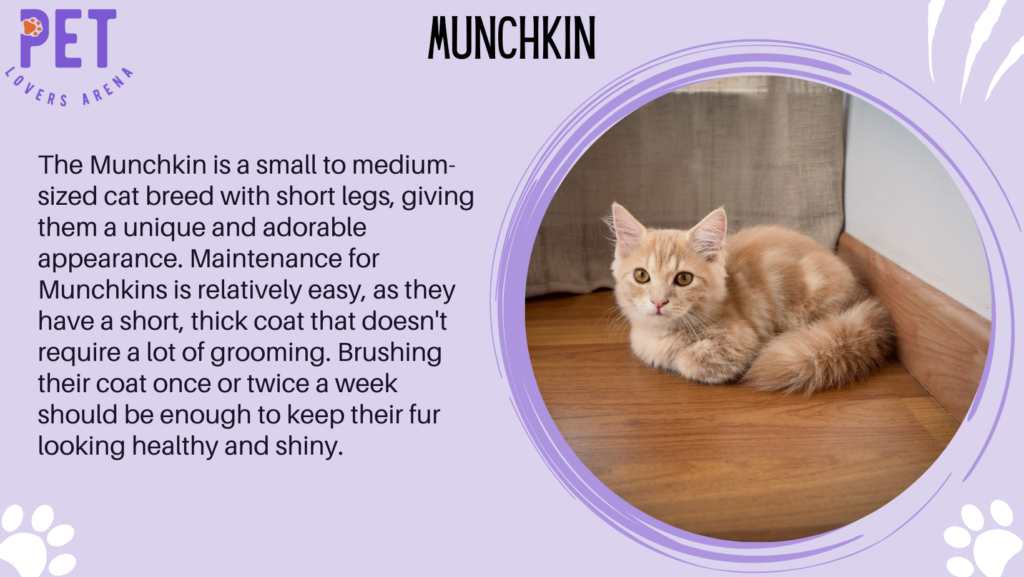
A Munchkin might be the perfect choice if you’re looking for a playful and affectionate cat breed that only requires a little space. The Munchkin is a small to medium-sized cat breed with short legs, giving them a unique and adorable appearance.
Maintenance for Munchkins is relatively easy, as they have a short, thick coat that doesn’t require a lot of grooming. Brushing their coat once or twice a week should be enough to keep their fur looking healthy and shiny.
Additionally, Munchkins are generally healthy cats with no major health issues specific to their breed, so regular check-ups with the vet should suffice.
33. American Longhair
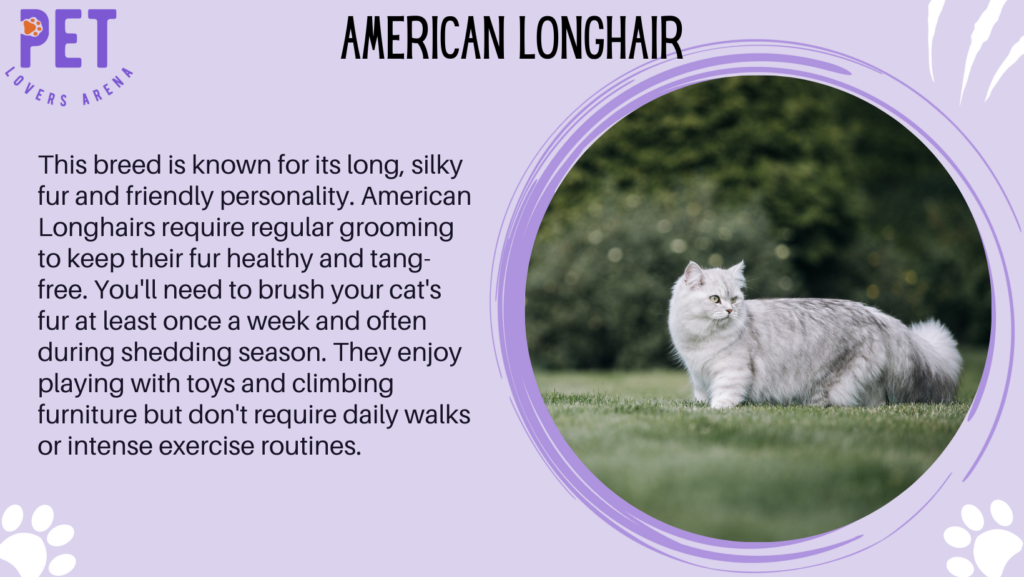
This breed is known for its long, silky fur and friendly personality. American Longhairs require regular grooming to keep their fur healthy and tang-free. You’ll need to brush your cat’s fur at least once a week and often during shedding season.
In terms of exercise, American Longhairs are relatively low-maintenance. They enjoy playing with toys and climbing furniture but don’t require daily walks or intense exercise routines.
American Longhairs are relatively inexpensive compared to other purebred cats. Depending on the breeder and location, you can expect to pay between $200 and $500 for a kitten. Remember that additional costs for vaccinations, spaying/neutering, and other veterinary care may exist.
34. American Curl
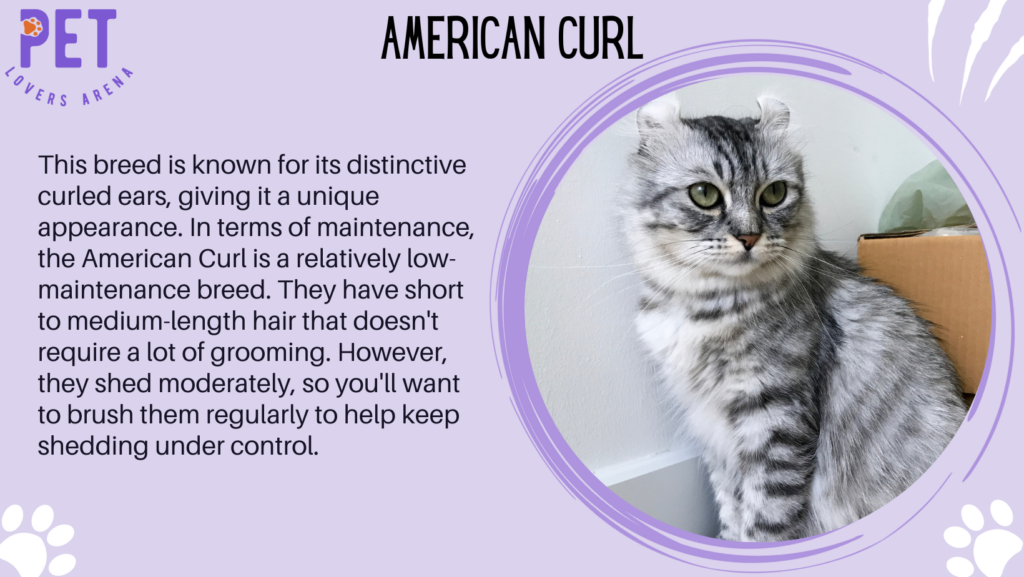
This breed is known for its distinctive curled ears, giving it a unique appearance. In terms of maintenance, the American Curl is a relatively low-maintenance breed. They have short to medium-length hair that doesn’t require a lot of grooming. However, they shed moderately, so you’ll want to brush them regularly to help keep shedding under control.
To keep your American Curl healthy, it’s important to schedule regular check-ups with your veterinarian and to keep up with their vaccinations. Your American Curl can be a happy and healthy companion with proper care and attention for many years.
35. Egyptian Mau
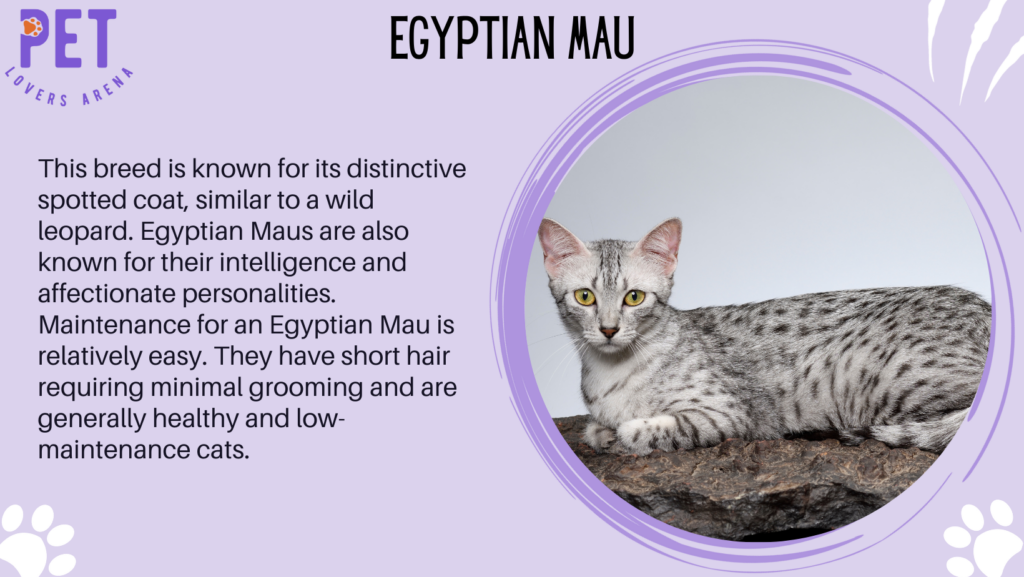
This breed is known for its distinctive spotted coat, similar to a wild leopard. Egyptian Maus are also known for their intelligence and affectionate personalities. Maintenance for an Egyptian Mau is relatively easy. They have short hair requiring minimal grooming and are generally healthy and low-maintenance cats.
However, like all cats, they require regular check-ups with a veterinarian to ensure they remain healthy. Egyptian Maus are also highly active cats and need plenty of exercise and playtime. They enjoy chasing toys, climbing, and running around, so it’s important to provide them with plenty of opportunities for physical activity.
36. American Bobtail
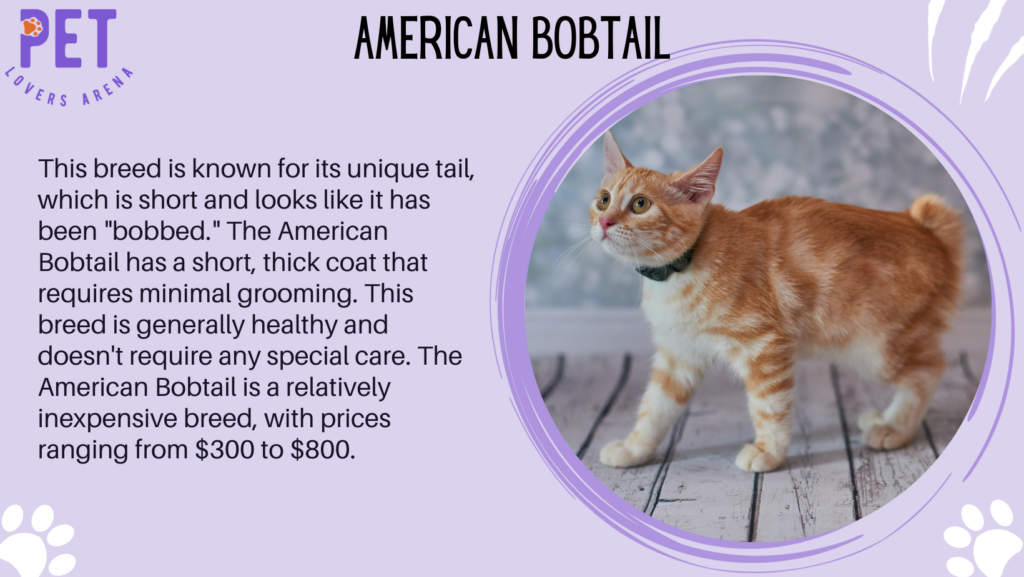
If you’re looking for a cat breed that is both friendly and playful, the American Bobtail is a great choice. This breed is known for its unique tail, which is short and looks like it has been “bobbed.” The American Bobtail has a short, thick coat that requires minimal grooming.
You should brush your cat once a week to remove loose hair and prevent matting. This breed is generally healthy and doesn’t require any special care. The American Bobtail is a relatively inexpensive breed, with prices ranging from $300 to $800. However, you may need to pay more if you’re looking for a show-quality cat.
37. Siamese

Siamese cats are an elegant and distinguished breed who have striking blue eyes and sleek coats. They are popular due to their affectionate and playful nature and low-maintenance grooming needs. A weekly brushing with a soft-bristled brush is sufficient to keep their coat looking healthy and shiny.
They are generally healthy cats, but like all breeds, they can be prone to specific health issues such as dental problems and respiratory infections. Regular check-ups with a vet are recommended. Providing them with toys, scratching posts, and interactive playtime can help keep them happy and healthy.
38. Ragamuffin
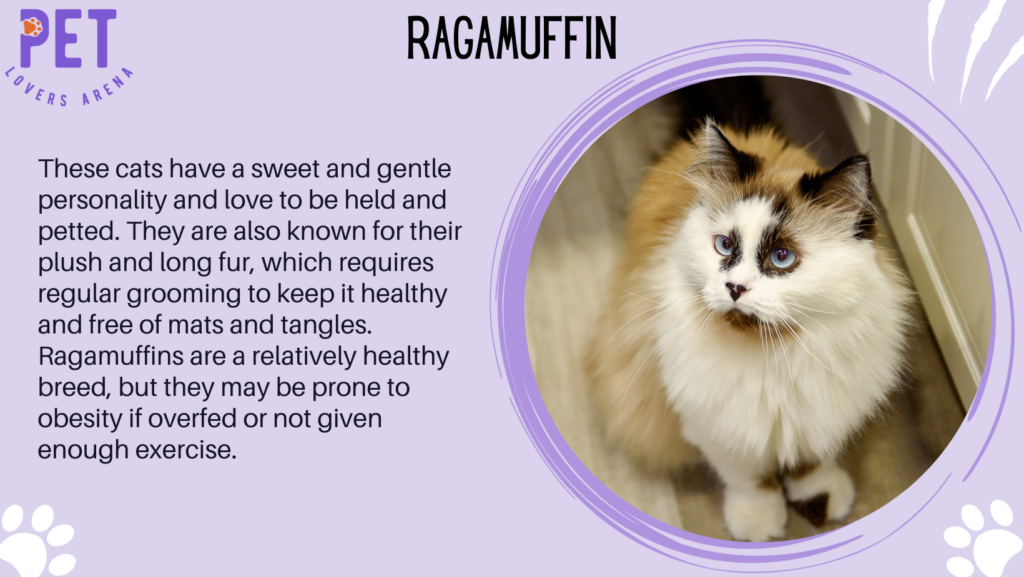
The Ragamuffin breed might be the perfect fit if you are looking for a large and cuddly cat. These cats have a sweet and gentle personality and love to be held and petted. They are also known for their plush and long fur, which requires regular grooming to keep it healthy and free of mats and tangles.
Provide them with a balanced diet and fresh water at all times. Keep them updated with their vaccinations and regular check-ups with a veterinarian. Ragamuffins are a relatively healthy breed, but they may be prone to obesity if overfed or not given enough exercise. They are also laid-back, so they may not be as active as other breeds.
39. Balinese
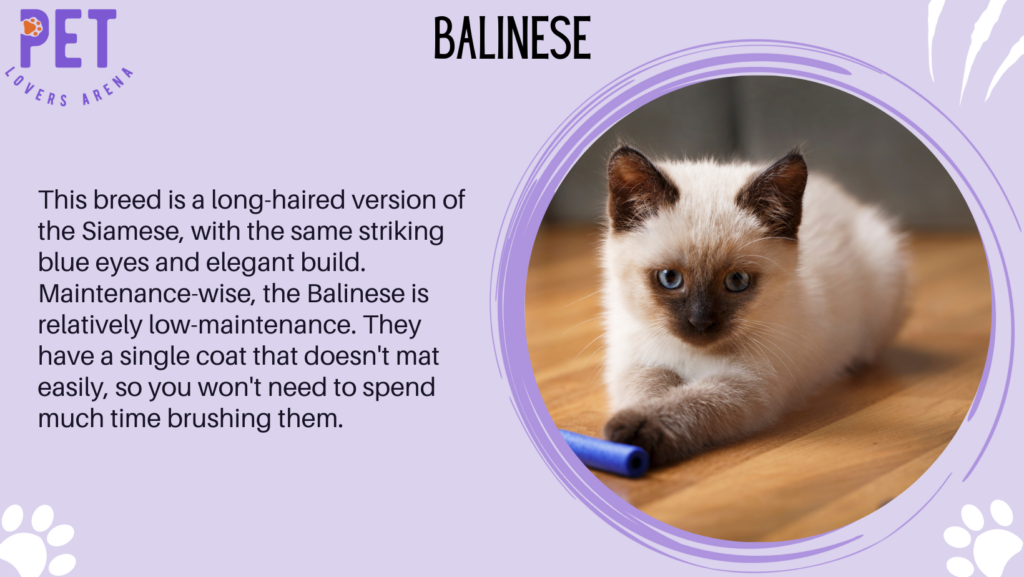
This breed is a long-haired version of the Siamese, with the same striking blue eyes and elegant build. Maintenance-wise, the Balinese is relatively low-maintenance. They have a single coat that doesn’t mat easily, so you won’t need to spend much time brushing them.
They’re also quite vocal, so be prepared for some meowing! Hence, the Balinese is worth considering if you’re looking for a beautiful, friendly cat that won’t break the bank.
Factors to Consider for Low-Maintenance Cat Care
When considering a low-maintenance cat, remember a few factors to ensure you can provide the necessary care for your feline friend. Here are some essential things to consider:
Grooming Needs
Low-maintenance cats typically have short hair and require minimal grooming. However, brushing your cat regularly to prevent hairballs and maintain a healthy coat is still essential. Additionally, cats with long hair may require more frequent grooming to avoid matting and tangling.
Health Issues
Some cat breeds are prone to specific health issues, requiring more frequent vet visits and higher medical costs. It’s essential to research the breed you’re interested in and ensure you can provide the necessary care to keep your cat healthy.
Activity Level
Low-maintenance cats tend to be more independent and require less attention than high-energy cats. However, providing your cat with enough mental and physical stimulation is essential to prevent boredom and destructive behavior.
Diet
Providing your cat with a well-balanced diet is essential for their health and well-being. Low-maintenance cats typically do not have any special dietary requirements, but it’s important to ensure that their food is high quality and meets their nutritional needs.
Benefits Of Adopting Low-Maintenance Cat Breeds
Adopting a low-maintenance cat breed can be an excellent decision for those who want a feline companion but don’t have much time or resources to dedicate to their care. Here are some of the benefits of adopting a low-maintenance cat breed:
- Less grooming required: Low-maintenance cat breeds generally require less grooming than high-maintenance breeds. This means you’ll spend less time brushing, bathing, and trimming your cat’s fur, which can save you time and money.
- Lower vet bills: Low-maintenance cat breeds are generally healthier and have fewer health issues than high-maintenance breeds. This means you’ll spend less money on vet bills and medications throughout your cat’s life.
- Less time required for exercise: Low-maintenance cat breeds are generally less active than high-maintenance breeds. This means you won’t need to spend as much time playing with or exercising your cat.
- Less time required for training: Low-maintenance cat breeds are generally more independent and require less training than high-maintenance breeds. This means you won’t need to spend as much time teaching your cat how to behave.
FAQ’s
If you’re looking for an affordable cat breed, consider adopting a domestic shorthair or longhair cat. These cats are widely available and can be found in animal shelters or rescue organizations for a low cost. They’re also known for being healthy and low-maintenance, making them an excellent choice for first-time cat owners.
The Siamese cat is a breed that is known for being easy to care for. They have short hair that doesn’t require much grooming and are generally healthy and low-maintenance. Siamese cats are also very social and affectionate, making them an excellent choice for families with children.
The Persian cat is a breed that is well-suited for indoor living. They’re inactive and prefer to lounge around the house, so they don’t require much space or exercise. Persians also have long, thick coats that require regular grooming but are generally quiet and low-maintenance.
If you’re looking for a cat that doesn’t shed much, consider a Sphynx or a Devon Rex. These breeds have concise, fine hair that doesn’t shed much, and they’re also known for being hypoallergenic. However, they do require regular grooming to keep their skin healthy.
If you’re looking for a cat that is independent and self-sufficient, you might want to consider a Maine Coon or a Norwegian Forest Cat. These breeds are known for being very independent and don’t require much attention or grooming. However, they can be quite large and may not be suited for small living spaces.
Conclusion
In conclusion, owning a cat can be an advantageous experience. However, choosing a breed that fits your lifestyle and budget is important. By considering the cheapest cat breeds with minimal maintenance, you can save money and time while still enjoying the companionship of a furry friend.
Remember, each cat breed has its own unique needs and personality. Providing adequate care and attention ensures your cat stays healthy and happy. Be sure to research each breed thoroughly before deciding and consult with a veterinarian if you have any questions or concerns.
Meet Fabian Wright, our guide into the animal realm at PetLoversArena.com. Having served as an Animal Care Specialist for the Ruwenzori Team at the Kansas City Zoo, he prioritizes conserving exotic species by replicating their habitats. Fabian aspires to share captivating stories of creatures, big and small, through PetLoversArena.com.

